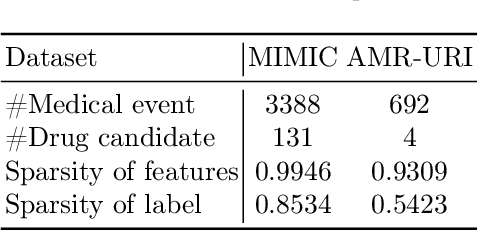Pei Gao
$\mathbb{BEHR}$NOULLI: A Binary EHR Data-Oriented Medication Recommendation System
Aug 18, 2024



Abstract:The medical community believes binary medical event outcomes in EHR data contain sufficient information for making a sensible recommendation. However, there are two challenges to effectively utilizing such data: (1) modeling the relationship between massive 0,1 event outcomes is difficult, even with expert knowledge; (2) in practice, learning can be stalled by the binary values since the equally important 0 entries propagate no learning signals. Currently, there is a large gap between the assumed sufficient information and the reality that no promising results have been shown by utilizing solely the binary data: visiting or secondary information is often necessary to reach acceptable performance. In this paper, we attempt to build the first successful binary EHR data-oriented drug recommendation system by tackling the two difficulties, making sensible drug recommendations solely using the binary EHR medical records. To this end, we take a statistical perspective to view the EHR data as a sample from its cohorts and transform them into continuous Bernoulli probabilities. The transformed entries not only model a deterministic binary event with a distribution but also allow reflecting \emph{event-event} relationship by conditional probability. A graph neural network is learned on top of the transformation. It captures event-event correlations while emphasizing \emph{event-to-patient} features. Extensive results demonstrate that the proposed method achieves state-of-the-art performance on large-scale databases, outperforming baseline methods that use secondary information by a large margin. The source code is available at \url{https://github.com/chenzRG/BEHRMecom}
Drugs Resistance Analysis from Scarce Health Records via Multi-task Graph Representation
Mar 08, 2023



Abstract:Clinicians prescribe antibiotics by looking at the patient's health record with an experienced eye. However, the therapy might be rendered futile if the patient has drug resistance. Determining drug resistance requires time-consuming laboratory-level testing while applying clinicians' heuristics in an automated way is difficult due to the categorical or binary medical events that constitute health records. In this paper, we propose a novel framework for rapid clinical intervention by viewing health records as graphs whose nodes are mapped from medical events and edges as correspondence between events in given a time window. A novel graph-based model is then proposed to extract informative features and yield automated drug resistance analysis from those high-dimensional and scarce graphs. The proposed method integrates multi-task learning into a common feature extracting graph encoder for simultaneous analyses of multiple drugs as well as stabilizing learning. On a massive dataset comprising over 110,000 patients with urinary tract infections, we verify the proposed method is capable of attaining superior performance on the drug resistance prediction problem. Furthermore, automated drug recommendations resemblant to laboratory-level testing can also be made based on the model resistance analysis.
ColluEagle: Collusive review spammer detection using Markov random fields
Nov 05, 2019



Abstract:Product reviews are extremely valuable for online shoppers in providing purchase decisions. Driven by immense profit incentives, fraudsters deliberately fabricate untruthful reviews to distort the reputation of online products. As online reviews become more and more important, group spamming, i.e., a team of fraudsters working collaboratively to attack a set of target products, becomes a new fashion. Previous works use review network effects, i.e. the relationships among reviewers, reviews, and products, to detect fake reviews or review spammers, but ignore time effects, which are critical in characterizing group spamming. In this paper, we propose a novel Markov random field (MRF)-based method (ColluEagle) to detect collusive review spammers, as well as review spam campaigns, considering both network effects and time effects. First we identify co-review pairs, a review phenomenon that happens between two reviewers who review a common product in a similar way, and then model reviewers and their co-review pairs as a pairwise-MRF, and use loopy belief propagation to evaluate the suspiciousness of reviewers. We further design a high quality yet easy-to-compute node prior for ColluEagle, through which the review spammer groups can also be subsequently identified. Experiments show that ColluEagle can not only detect collusive spammers with high precision, significantly outperforming state-of-the-art baselines --- FraudEagle and SpEagle, but also identify highly suspicious review spammer campaigns.
 Add to Chrome
Add to Chrome Add to Firefox
Add to Firefox Add to Edge
Add to Edge